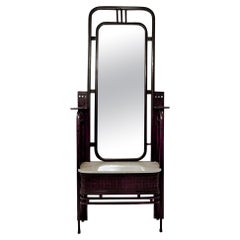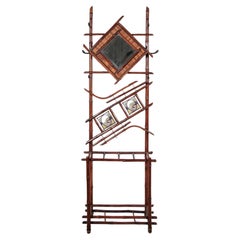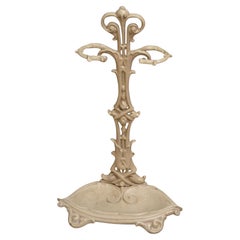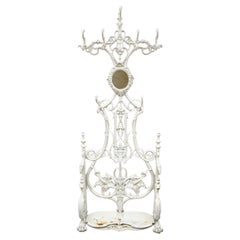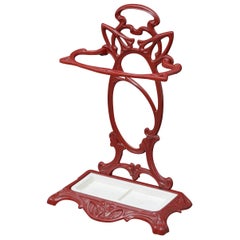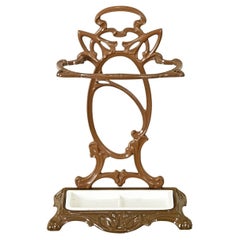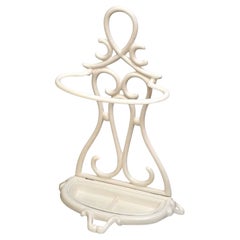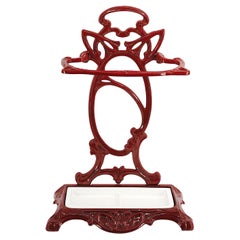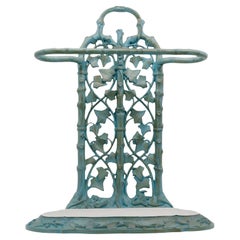Art Nouveau Hall Stand
to
62
354
155
517
4
454
12
4
3
2
106
410
4
363
20
7
160
31
34
6
1
4
1
3
266
259
117
96
85
452
172
135
43
34
520
517
517
39
35
14
7
7
Sort By
Art Nouveau Hall Stand in the Style of Joseph Hoffmann, 1930s
Located in Brussels, BE
Art Nouveau Hall stand in the style of Joseph Hoffmann, 1930s.
Category
Vintage 1930s Art Nouveau Coat Racks and Stands
Materials
Wood
Art Nouveau Bamboo Stand Hall Mirror Coat Rack & Majolica French Folk Art Tiles
Located in Antwerp, BE
French Antique Art Nouveau bamboo hall coat rack and umbrella stand. Original French bamboo coat
Category
Antique Early 1900s French Art Nouveau Coat Racks and Stands
Materials
Ceramic, Bamboo, Mirror
$1,815 Sale Price
20% Off
H 74.81 in W 31.5 in D 11.82 in
French Art Nouveau Stick Stand
Located in Whaley Bridge, GB
K0293 French Art Nouveau umbrella stand of flowing organic form. This antique hall stand retains
Category
Antique 1880s French Art Nouveau Coat Racks and Stands
Materials
Iron
Antique French Art Nouveau Cast Iron Hall Tree Mirror Stand attr Alfred Corneau
Located in Philadelphia, PA
Antique French Art Nouveau Cast Iron Hall Tree Stand attributed to Alfred Corneau. Item features
Category
Antique 19th Century Art Nouveau Coat Racks and Stands
Materials
Iron
$3,950
H 76.5 in W 29.5 in D 10.5 in
Stylish Art Nouveau Umbrella Stand
Located in Whaley Bridge, GB
K027 An exceptional, French Art Nouveau, cast iron umbrella stand / hall stand with flowing organic
Category
Antique Early 1900s French Art Nouveau Umbrella Stands
Materials
Iron
French Art Nouveau Umbrella Stand
Located in Baton Rouge, LA
A sculptural turn of the century (circa 1900) French Art Nouveau umbrella stand, rendered in cast
Category
20th Century French Art Nouveau Umbrella Stands
Materials
Enamel, Iron
French Art Nouveau Enameled Umbrella Stand - Stick Stand
Located in Whaley Bridge, GB
K088 Stylish French, Art Nouveau cast iron umbrella stand of organic design, having original drip
Category
Early 20th Century French Art Nouveau Umbrella Stands
Materials
Iron
$923 Sale Price
20% Off
H 29.13 in W 18.11 in D 24.5 in
Rare Art Nouveau Umbrella Stand, 1900
By Hector Guimard
Located in Saint-Amans-des-Cots, FR
French Art Nouveau cast iron umbrella stand, circa 1900. Rare in this color. This exquisite French
Category
Antique Early 1900s French Art Nouveau Umbrella Stands
Materials
Iron
French Art Nouveau Umbrella Stand, 1900
Located in Saint-Amans-des-Cots, FR
French Art Nouveau umbrella stand, France, ca.1900. Patinated cast iron. Removable tank. Height
Category
Early 20th Century French Art Nouveau Umbrella Stands
Materials
Iron
Antique Art Nouveau Stick Stand, French, Brass, Hall, Umbrella Rack, Victorian
Located in Hele, Devon, GB
This is an antique Art Nouveau stick stand. An French, cast brass hallway umbrella rack, dating to
Category
Antique Late 19th Century French Umbrella Stands
Materials
Brass
$1,332
H 26.19 in W 11.82 in D 7.68 in
French Art Nouveau Umbrella Stand, 1900
Located in Saint-Amans-des-Cots, FR
French Art Nouveau umbrella stand, France, ca.1900. Black and white enameled cast iron (fixture and
Category
Early 20th Century French Art Nouveau Umbrella Stands
Materials
Iron
Antique Demi-Lune Stick Loop, English Brass, Hall Stand, Art Nouveau, Victorian
Located in Hele, Devon, GB
character and practical charm to any portico, vestibule or entrance hall.
Attractive Art Nouveau period
Category
Early 20th Century British Late Victorian Umbrella Stands
Materials
Brass
$1,370
H 25.99 in W 14.57 in D 7.88 in
Art Nouveau Walnut Hatrack & Umbrella Stand
Located in Queens, NY
French Art Nouveau walnut and maple hatrack with a large center mirror having whiplash carving and
Category
Antique Late 19th Century French Art Nouveau Coat Racks and Stands
Materials
Brass, Bronze
French Cast Iron Art Nouveau Umbrella Stand
Located in Baton Rouge, LA
A calligraphic French Art Nouveau umbrella stand, made of cast iron enameled in a glossy oxblood
Category
20th Century French Art Nouveau Umbrella Stands
Materials
Iron
Victorian Mahogany Hall Stand
Located in Godshill, Isle of Wight
Victorian mahogany hall stand
This is a handsome piece, the stand has an imposing Swan Neck
Category
Antique Late 19th Century Art Nouveau Coat Racks and Stands
Materials
Mahogany
Art Nouveau Carved Paper Basket/Umbrella Stand
Located in Banská Štiavnica, SK
Art nouveau carved paper basket in very good original condition.
Category
Antique Early 1900s French Art Nouveau Umbrella Stands
Materials
Wood
French Art Nouveau Iron Umbrella Stand with Frogs
Located in Houston, TX
French Art Nouveau iron umbrella stand with frogs.
Whimsical French Art Nouveau patinated wrought
Category
Vintage 1920s European Art Nouveau Umbrella Stands
Materials
Iron
Art Nouveau Beaten Copper Stick and Umbrella Stand
Located in Altrincham, GB
Art Nouveau Beaten Copper Stick and Umbrella Stand with Stylised Embossed Tulips - 10.5"diam x 26.5
Category
Antique Early 1900s English Art Nouveau Umbrella Stands
Materials
Copper
Art Nouveau Victorian Cast Iron Hall Stand in the manner of Christopher Dresser
By Christopher Dresser
Located in Whaley Bridge, GB
K0306 Very stylish English Victorian cast iron hall stand / coat stand in the manner of Christopher
Category
Antique 19th Century English Coat Racks and Stands
Materials
Iron
$4,923 Sale Price
20% Off
H 77.56 in W 31.1 in D 13.39 in
Italian Art Nouveau Liberty Brass Umbrella Stand, 1930s
Located in Traversetolo, IT
The beautiful Italian Art Nouveau Liberty umbrella stands from the 1950s has a great executive
Category
Vintage 1930s Italian Art Nouveau Umbrella Stands
Materials
Brass
$1,433 Sale Price
20% Off
H 25.2 in W 14.57 in D 10.63 in
Oak Art Nouveau Arts & Crafts Umbrella Stand, 1900s
Located in Amsterdam, NL
Stunning and rare Art Nouveau Arts & Crafts umbrella stand.
Striking Dutch design from the 1900s
Category
Antique Early 1900s Art Nouveau Umbrella Stands
Materials
Brass
$525 Sale Price
20% Off
H 34.06 in W 18.12 in D 9.65 in
Art Nouveau Beech Bentwood Hat and Coat Stand, 1900s
Located in Amsterdam, NL
Stunning and elegant Art Nouveau hat and coat stand.
Design in the style of Thonet and Jacob and
Category
Antique Early 1900s French Art Nouveau Coat Racks and Stands
Materials
Beech
19th Century Art Nouveau Painted Cast Iron Umbrella Stand
Located in Petworth,West Sussex, GB
This late nineteenth-century Art Nouveau period cast iron umbrella stand or stick stand, dating to
Category
Antique Late 19th Century French Art Nouveau Umbrella Stands
Materials
Iron
Art Nouveau Umbrella Stand in Hammered Embossed Copper
Located in Langemark-Poelkapelle, BE
Highly decorative brass & copper umbrella stand. This entirely handcrafted, early 1900s hall stand
Category
Early 20th Century French Art Nouveau Umbrella Stands
Materials
Brass, Copper, Zinc
$812 Sale Price
20% Off
H 24.41 in W 15.36 in D 15.36 in
Art Nouveau Coat Stand done in Wrought Iron // France 1910s
By Koloman Moser
Located in Beograd, RS
In this listing you will find a gorgeous Art Nouveau standing coat rack. This magnificent and very
Category
Vintage 1910s French Art Nouveau Coat Racks and Stands
Materials
Wrought Iron
French Art Nouveau Cast Iron Hall Tree By Alfred Corneau ca.1900
By Alfred Corneau
Located in Austin, TX
Emanating the spirit of the Art Nouveau movement, this French Cast Iron Hall Tree by Alfred Corneau
Category
Antique Early 1900s French Art Nouveau Coat Racks and Stands
Materials
Iron
$2,720 Sale Price
20% Off
H 69.5 in W 39 in D 15.5 in
Art Nouveau Umbrella Stand Basket Embossed Leather Decorated Red Roses
Located in Hannover, DE
different colors. This lovely Art Nouveau umbrella stand is sure to catch your eye with its elegant design
Category
Antique Early 1900s German Art Nouveau Umbrella Stands
Materials
Leather, Pine
$716
H 19.69 in W 10.04 in D 9.45 in
Antique Art Nouveau Brown & Green Majolica Pottery Walking Stick Umbrella Stand
Located in Philadelphia, PA
Antique Art Nouveau Brown & Green Majolica Pottery Walking Stick Umbrella Stand. Circa Late 19th
Category
Antique Late 19th Century Art Nouveau Umbrella Stands
Materials
Pottery
$650
H 20 in W 11 in D 11 in
Antique Art Nouveau Stick Stand, French, Hallway, Umbrella Rack, Late Victorian
Located in Hele, Devon, GB
This is an antique Art Nouveau stick stand. An French, cast metal hallway umbrella rack, dating to
Category
Antique Late 19th Century French Art Nouveau Umbrella Stands
Materials
Metal
$1,053
H 27.96 in W 12.01 in D 7.68 in
Italian Art Nouveau yellow and green wrought iron umbrella stand, 1900s
Located in MIlano, IT
Italian Art Nouveau yellow and green wrought iron umbrella stand, 1900s
Wrought iron umbrella stand
Category
Antique Early 1900s Italian Art Nouveau Umbrella Stands
Materials
Iron
$1,887
H 28.15 in W 28.75 in D 13 in
19th Century Art Nouveau Fancy Braided Wicker Hat or Coat Stand
Located in Savannah, GA
This rare 19th century wicker hat/coat stand features a very unusual loosely woven braid over a
Category
Antique 1890s American Art Nouveau Hat Racks and Stands
Materials
Wicker, Wood
$595 Sale Price
60% Off
H 66 in W 18 in D 18 in
Antique bedside cabinet Art Nouveau around 1900 Walnut & marble
Located in Würzburg, DE
✓ High-quality walnut
✓ Classic Art Nouveau shapes
✓ Noble marble top
Dimensions: W: 37cm H: 79cm
Category
Antique Early 1900s French Art Nouveau Candle Stands
Materials
Marble
$1,170
H 31.11 in W 14.57 in D 14.18 in
20s Italian Handmade Wrought Iron Umbrella Stand Art Nouveau Style Bronze Saucer
By Jacques Adnet, Arthur Umanoff
Located in Miami, FL
1920s Art Nouveau Style handmade Wrought Iron Umbrella Stand made in Italy.
Comes with a Bronze
Category
Vintage 1920s Italian Art Nouveau Umbrella Stands
Materials
Bronze, Wrought Iron
$2,030 Sale Price
30% Off
H 23.25 in Dm 11 in
French Art nouveau hall tree / coat rack by Emile galle 1905 marquetry hallway
By Émile Gallé
Located in Ijzendijke, NL
.
Featuring exquisite craftsmanship and a timeless design. the coat rack comes with its original 9 art nouveau
Category
Antique Early 1900s French Art Nouveau Coat Racks and Stands
Materials
Brass, Bronze
$11,785
H 90.56 in W 47.64 in D 9.06 in
Corner Umbrella Stand Art Nouveau in Brass and Oak Attributable Josef Hoffmann
By Josef Hoffmann
Located in Vigonza, Padua
Early 20th century corner umbrella stand Art Nouveau in brass and oak attributable to Josef
Category
Early 20th Century Austrian Art Nouveau Umbrella Stands
Materials
Brass
$8,123
H 56.3 in W 17.72 in D 15.75 in
Antique quality C1900 painted towel rail stand Art Nouveau
Located in Wisbech, Cambridgeshire
Antique, high-quality circa 1900 painted towel rail stand in Art Nouveau style, boasting a
Category
Antique Early 1900s Coat Racks and Stands
Materials
Wood
$680 Sale Price
30% Off
H 31.11 in W 27.17 in D 11.03 in
Art Nouveau Coat Hanger
Located in Banská Štiavnica, SK
Art Nouveau coat hanger.
Category
Antique Early 1900s Slovak Art Nouveau Coat Racks and Stands
Materials
Fabric, Wood
20th Century Austrian Art Nouveau Vintage Brass Coat Stand, Rack by Adolf Loos
By Adolf Loos
Located in West Palm Beach, FL
An early 20th Century, vintage Austrian Art Nouveau coat rack made of hand crafted brass designed
Category
Antique Early 19th Century Austrian Art Nouveau Hat Racks and Stands
Materials
Metal, Brass
$9,900
H 80 in W 19.75 in D 19.75 in
Patinated Brass Arts & Crafts Art Nouveau Umbrella Stand, 1900s
Located in Amsterdam, NL
Stunning and ultra rare Arts & Crafts Art Nouveau umbrella stand.
Striking Dutch design from the
Category
Antique Early 1900s Dutch Arts and Crafts Umbrella Stands
Materials
Brass
$1,099 Sale Price
20% Off
H 22.05 in Dm 15.75 in
Antique Decorative Stick Stand, French, Umbrella Rack, Art Nouveau, Victorian
Located in Hele, Devon, GB
Flourishes of Art Nouveau motif decorate the stand
Pair of unusual oval stick loops, accentuated with beaded
Category
Antique Late 19th Century French Umbrella Stands
Materials
Iron
$1,724
H 25.01 in W 16.54 in D 7.68 in
Antique Victorian walnut Towel Rail Stand - Quality Art Nouveau C1900
Located in Wisbech, Cambridgeshire
Antique Victorian walnut Towel Rail Stand - Quality Art Nouveau from circa 1900.
Solid
Category
Antique Early 1900s Coat Racks and Stands
Materials
Wood
$778 Sale Price
30% Off
H 33.47 in W 27.17 in D 11.42 in
Antique Victorian mahogany Towel Rail Stand - Quality Art Nouveau C1900
Located in Wisbech, Cambridgeshire
Antique Victorian Mahogany Towel Rail Stand - Quality Art Nouveau from circa 1900.
Solid
Category
Antique Early 1900s Coat Racks and Stands
Materials
Wood
$889 Sale Price
20% Off
H 34.65 in W 25.2 in D 9.85 in
Arts & Crafts Style Scrolling Wrought Iron Mirror Umbrella Stand Coat Hall Tree
Located in Philadelphia, PA
Vintage Arts & Crafts Style Scrolling Wrought Iron Mirror Umbrella Stand Coat Hall Tree with Rusty
Category
Mid-20th Century Unknown Art Nouveau Coat Racks and Stands
Materials
Mirror
$695
H 77 in W 39 in D 9 in
Vintage Decorative Stick Stand, Cast Iron, Hallway, Umbrella Rack, Art Nouveau
Located in Hele, Devon, GB
Art Nouveau taste, dating to the late 20th century, circa 1980.
Profusely detailed in the tradition
Category
Late 20th Century Umbrella Stands
Materials
Iron
$2,293
H 31.89 in W 29.14 in D 13 in
Art Nouveau Brass Coat Hook
Located in Vienna, AT
Cast brass restored, made in Austria, circa 1900
Up to 3 available, price per piece.
Category
Antique Early 1900s Austrian Art Nouveau Hat Racks and Stands
Materials
Brass
Art Nouveau Brass Coat Hook
Located in Vienna, AT
Cast brass, made in Austria, circa 1900-1910.
Up to 3 pieces available price per piece.
Delivery time 3-4 weeks.
Category
Antique Early 1900s Austrian Art Nouveau Hat Racks and Stands
Materials
Brass
Art Nouveau Brass Coat Hook
Located in Vienna, AT
Cast brass made in Austria, circa 1900-1910.
Up to 4 pieces available price per piece.
Delivery time 3-4 weeks.
Category
Antique Early 1900s Austrian Art Nouveau Hat Racks and Stands
Materials
Brass
Art Nouveau Brass Coat Hook
Located in Vienna, AT
Cast brass restored, made in Austria, circa 1900
Up to 3 available, price per piece.
Category
Antique Early 1900s Austrian Art Nouveau Hat Racks and Stands
Materials
Brass
Art Nouveau Brass Coat Hook
Located in Vienna, AT
Cast brass made in Austria, circa 1900.
Category
Antique Early 1900s Austrian Art Nouveau Hat Racks and Stands
Materials
Brass
Art Nouveau Brass Coat Hook
Located in Vienna, AT
Cast brass made in Austria, circa 1900.
Category
Antique Early 1900s Austrian Art Nouveau Hat Racks and Stands
Materials
Brass
Art Nouveau Bronze Coat Hook
Located in Vienna, AT
Cast bronze made in Austria, circa 1900-1910.
Category
Antique Early 1900s Austrian Art Nouveau Hat Racks and Stands
Materials
Brass
Art Nouveau Brass Coat Hook
Located in Vienna, AT
Cast brass made in Austria, circa 1900.
Category
Antique Early 1900s Austrian Art Nouveau Hat Racks and Stands
Materials
Brass
Art Nouveau Brass Coat Hook
Located in Vienna, AT
Cast brass made in Austria about 1900
up to three available
Category
Antique Early 1900s Austrian Art Nouveau Hat Racks and Stands
Materials
Brass
Art Nouveau Brass Coat Hook
Located in Vienna, AT
Cast brass made in Austria, circa 1900
Up to six available, price per piece.
Category
Antique Early 1900s Austrian Art Nouveau Hat Racks and Stands
Materials
Brass
Art Nouveau Brass Coat Hook
Located in Vienna, AT
Cast brass made in Austria, circa 1900.
Category
Antique Early 1900s Austrian Art Nouveau Hat Racks and Stands
Materials
Brass
Art Nouveau Brass Coat Hook
Located in Vienna, AT
Cast brass made in Austai, circa 1900-1910.
Category
Antique Early 1900s Austrian Art Nouveau Hat Racks and Stands
Materials
Brass
Vintage Hallway Stick Stand, English Cast Iron, Umbrella Rack, Art Nouveau Taste
Located in Hele, Devon, GB
hallway stick stand, the Art Nouveau taste well suited to most reception halls. Delivered polished and
Category
Mid-20th Century British Umbrella Stands
Materials
Iron
$1,332
H 22.45 in W 13.98 in D 8.27 in
German Art Nouveau Oakwood Coat Rack
Located in Darmstadt, DE
Very beautiful small Art Nouveau Coat Rack in oakwood with original hooks. The Wall Coat Rackhas a
Category
Antique Early 1900s German Art Nouveau Coat Racks and Stands
Materials
Tin
- 1
Get Updated with New Arrivals
Save "Art Nouveau Hall Stand", and we’ll notify you when there are new listings in this category.
Art Nouveau Hall Stand For Sale on 1stDibs
At 1stDibs, there are many versions of the ideal art nouveau hall stand for your home. Frequently made of wood, metal and bentwood, every art nouveau hall stand was constructed with great care. If you’re shopping for an art nouveau hall stand, we have 243 options in-stock, while there are 4 modern editions to choose from as well. Your living room may not be complete without an art nouveau hall stand — find older editions for sale from the 19th Century and newer versions made as recently as the 21st Century. Each art nouveau hall stand bearing Art Nouveau, Arts and Crafts or Art Deco hallmarks is very popular. You’ll likely find more than one art nouveau hall stand that is appealing in its simplicity, but Thonet, Michael Thonet and Jacob and Josef Kohn produced versions that are worth a look.
How Much is a Art Nouveau Hall Stand?
The average selling price for an art nouveau hall stand at 1stDibs is $1,600, while they’re typically $98 on the low end and $27,597 for the highest priced.
